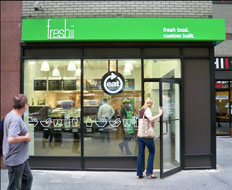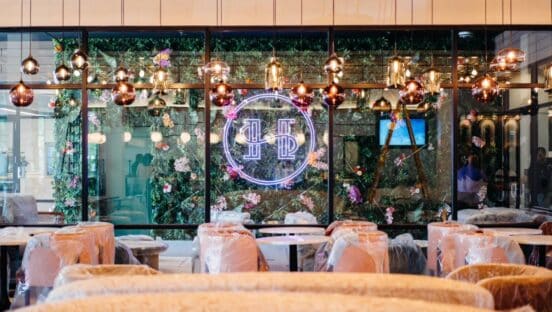Now that many domestic brands are looking overseas for growth opportunities—and with Americans’ taste for ethnic flavors continuing to grow—international quick-service and fast-casual chains are expanding their presence in the U.S. The many up-and-coming operators offer stiff competition to myriad U.S. chains, including those in the chicken, Asian, baked goods, and sandwich categories.
International chains that have made inroads into the U.S. market include YO! Sushi, Wegamama, Soho House, Pret A Manger, Nando’s Peri Peri, Pollo Campero, La Tasca, Little Sheep Mongolian Hot Pot, Pie Face, Giraffas, and Freshii.
“What [international chain operators] see when they examine the U.S. market is a consumer who spends almost half of their food budget at restaurants, and one who is eager to try new ethnic flavors. U.S. operators ignore these international imports at their peril,” says Darren Tristano, executive vice president of Chicago-based foodservice consulting firm Technomic, which recently published a report on international chains expanding to the U.S.
International operators tend to target affluent or middle-class customers in urban markets, Tristano says. “They are looking for markets where there is a high percentage of people dining out, such as Washington, D.C., New York City, Miami, and Chicago,” he says. “Many are looking for very hip, temporary locations that draw a big business crowd.”
The overseas operators that have realized success in the U.S. market have some qualities in common, Tristano adds, including a focus on innovative, authentic flavors and convenient and flexible formats.
Pollo Campero is one proven model of a stateside, internationally based restaurant chain. Based in Guatemala, with U.S. headquarters in Dallas, Pollo Campero operates around 50 stores in the U.S. and continues to grow. The company is successful because of its “Latin approach to the [quick-service] chicken experience,” says Tim Pulido, CEO of Pollo Campero. Entrees on the menu include grilled chicken flavored with Latin spices and citrus, empanadas, a salsa bar, and sides made fresh in the kitchen.
“It is really seen as a home treat for Americans from Guatemala and El Salvador,” he says.
While Pollo Campero’s menu includes both fried and grilled chicken, Pulido says the operator does not want to compete with the likes of KFC, Chick-fil-A, and Zaxby’s. “We are not trying to be Southern fried chicken; that market is extremely crowded. Instead, we are trying to focus on Latin authenticity and fresh flavor,” he says.
But El Pollo Loco and Pollo Tropical—domestic chains with international flare—do offer stiff competition to Pollo Campero. As a result, the Guatemalan chain is testing a new fast-casual concept at four stores in Houston. “We are looking at how we can make this brand go more mainstream,” Pulido says. “We are trying to take this authentic Latin essence … to the next level, and adapt it to the U.S.”
The pilot stores feature an open kitchen layout where guests can see chicken being grilled and salads being made, something Pulido says adds theater to the experience. Different menu items are featured in the fast casual, including Peruvian Citrus Grilled Chicken, several salads, and six different tacos.
Recently, Pollo Campero acquired two big groups of stores, one each in New York City and Washington, D.C., that were previously franchise-owned. Around 20 of its units are now corporate owned. "We wanted to have a stronger corporate presence and be concentrated in a couple of markets. If you plant the flag everywhere, you will get nowhere," Pulido says.
Pollo Campero plans to continue its U.S. expansion, with plans to open “double-digit” units annually, Pulido says. He adds that the New York and Washington, D.C., markets are where the company plans to focus much of its growth.
Toronto-based Freshii, with U.S. headquarters in Chicago, has also found success since its entry into the U.S. market in 2007. With 80 stores in the U.S. and 340 stores under contract over the next seven years, the chain plans to grow quickly.
“What we did for the last two years is try to find great partners and have them develop multiple stores. Most of them will open a store or two a year, in 30–40 cities at a time,” says Matthew Corin, CEO of Freshii. The chain, which offers salads, soups, burritos, breakfast items, and other fresh food, has succeeded because of the balance it has struck between size and brand, Corin says.
“We are growing very quickly for a brick-and-mortar operation,” he says. “If you just evolve, you are not going to get the benefit of scale and if you just scale, people will be doing interesting things around you and steal your business.”
Corin says Freshii is also strengthening its roots in the U.S. by cornering a new restaurant category: “health casual.”
“Health casual is using interesting sauces and flavors that are based on spice instead of a ton of fat,” he says. “There is an incredible emergence of [health-casual] brands rising across the country, and we are definitely the market leader in this space.”
Freshii’s healthy menu ingredients include brown rice, quinoa, and kale. Corin sees primarily localized competition for the Freshii concept, such as Imo’s in Chicago.
Though Asian food has long been a staple here, international brands are starting to carve their own Asian niches in the U.S. market. This year, London-based YO! Sushi opened its first franchised store in Washington, D.C.’s Union Station. The concept has been successful in the U.K. since 1997 with its conveyor-belt sushi model, which aims to make Japanese food more accessible and affordable.
“The emphasis on healthy eating in the U.S. really played well into our hand, as sushi is such a healthy product,” says Alison Vickers, business development director for YO! Sushi.
[pagebreak]
As a result, YO! Sushi plans to open between five and 10 U.S. locations over the next two years, starting with the Philadelphia and metropolitan Washington, D.C., areas. Company executives are also looking at sites in Boston, Chicago, Miami, Atlanta, and Dallas.
“We are very particular on site location, and prefer to select the absolute right location and go a bit slower than choosing marginal locations,” Vickers says. “We are an urban concept, and work very well in higher-end shopping malls, transport locations [like] large railway stations and airports, as well as heavy footfall downtowns.”
While there are many Asian restaurant chains in the U.S., not many of them are focused solely on Japanese cuisine, Vickers says. “We believe competition comes from urban brands with similar check averages who offer consumers fresh, flavorful menu choices in a vibrant environment quickly,” she says.
Like YO! Sushi, many international quick-service operators test the waters in the U.S. market with just one store. “Sometimes they will use it as an innovation kitchen to test everything,” Tristano says. “They need to present a solid economic case in order to invest the company’s and franchisees’ money.”
For example, Nando’s Peri-Peri, based in Johannesburg, South Africa, started with one unit in Washington, D.C., in 2008 and now has multiple locations in the nation’s capital. The concept offers a unique twist on standard quick-service chicken chains: Nando’s specializes in Portuguese-style peri-peri chicken, which is basted with a spicy sauce.
“Units, averaging 3,800 square feet, operate primarily in high-visibility sites that have multiple levels,” states Technomic’s recent “International Imports” report.
While international quick-service brands continue to plant flags on U.S. soil, none are guaranteed success, experts say. They face many challenges, including adapting their operating models and menus to U.S. consumers. “A number of these chains have had so much success in the country or trade area in which they operate, they believe they just have to open in America and they will have success,” Tristano says.
Lane Cardwell, president of Cardwell Hospitality Advisory and former president of P.F. Chang’s, also says international brands face an uphill battle stateside. “A successful international entrant into the U.S. is always a strong brand in their home market and often in other countries around the world,” he says. “They begin with this advantage, but it usually isn’t enough of an advantage to translate into immediate success in the U.S.”
As a result, most international brands choose franchise partners to grow their brand and raise awareness in the U.S. Still, the biggest challenge the operators face early on is site selection, Cardwell says. “Most strong international brands find their expansion in the U.S. goes slower than in other countries,” he says. “Urban D.C., Chicago, and New York City have become the go-to cities for initial franchising.”
International brands that have grown slower in the U.S. than expected, Cardwell says, include YO! Sushi, Nando’s, and Wegamama.
Pret A Manger has also grown slower than expected and has had a learning curve with U.S. consumers’ tastes and habits. The London-based grab-and-go sandwich chain was not successful for a period of time after it opened its first U.S. unit in New York City in 2000, says Martin Bates, president of Pret A Manger USA.
“We came over thinking that we could transplant our London shops in New York,” Bates says. “We have been doing this for a long time in the U.K., where people eat pre-made, grab-and-go food. In this market, it is very much a customized product.
“We have had to really educate people about the fact that we have a kitchen in the shop, it is made fresh, and it is put on the shelf in the last hour,” he adds. Pret A Manger also added more drip coffee machines instead of highlighting espresso machines, as it does in the U.K.
Since tweaking its U.S. concept, Pret A Manger has grown to 50 stores in New York City, D.C., Chicago, and Boston and boasts an annual sales growth of 40 percent. Company executives plan to add 15–20 stores in the U.S. in 2013, and another 15–20 stores in 2014. “We don’t want to grow too fast. We have a key core culture that is hopefully evident in our shops, which we own and manage [instead of franchise],” Bates says.
Although Pret A Manger executives keep an eye on Panera Bread and Chipotle, Bates says no other quick-service or fast-casual chain “does quite what we do.”
London-based Asian noodle chain Wegamama, which has three stores in the Boston area, also needed to make some changes to its restaurants to appeal to U.S. customers. “Communal dining is comfortable to European culture, but not to Americans, so they added booths to their stores,” Tristano says.
Likewise, YO! Sushi needed to adapt its offerings to American consumers. “Generally, the U.S. serves larger portions than the U.K. However, with sushi and small plates of Japanese classics, this was an easier transfer,” Vickers says. In addition, Americans expect free refills on soda and iced tea, whereas U.K. consumers do not, so YO! Sushi modified the drink menu to meet customer demands, she says.







